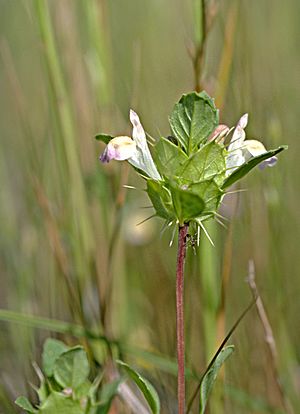San Mateo thornmint facts for kids
Quick facts for kids San Mateo thornmint |
|
|---|---|
 |
|
| Conservation status | |
| Scientific classification | |
| Genus: |
Acanthomintha
|
| Species: |
duttonii
|
The Acanthomintha duttonii is a special type of plant. It is an annual plant, which means it lives for only one year. This plant is found only in San Mateo County, California. People often call it the San Mateo thornmint. It grows on a unique type of ground called serpentine soils. You can find it near the Crystal Springs Reservoir. It lives in a strip of land about 10 kilometers (6 miles) long. This area is on the east side of Montara Mountain, at heights of about 150 to 300 meters.
Contents
What is the San Mateo Thornmint?
The San Mateo thornmint is a small, sweet-smelling wildflower. It has square stems that stand up straight. Its leaves have clear veins and often have spiny edges. The plant's name, "thornmint," comes from the spiny parts around its flowers.
How it Looks
The San Mateo thornmint usually has a single stem. This stem is less than 20 centimeters (about 8 inches) long. It might have short hairs or no hairs at all. Its leaves are about 8 to 12 millimeters long. They are shaped like a spear or an oval. Sometimes, the edges of these spiny leaves are jagged.
The flowers grow in clusters at the top of the stem. The parts around the flowers are called bracts. These bracts are oval-shaped and green. They have five or seven spines on their edges. The flowers themselves are white and can sometimes have a light purple color. The inside of the flower is creamy white.
Like most mints, the flowers have two "lips." The upper lip is like a small hood. The lower lip is longer and has three parts that bend backward. The plant blooms from April until late June. Each flower that gets fertilized makes four nut-like seeds. This plant can fertilize itself, which means it does not need another plant to make seeds.
How it is Different
This plant is named after Harry Arnold Dutton. He found another rare plant nearby in 1949. The San Mateo thornmint is special because its upper stamens (the parts that make pollen) are fertile. Other similar thornmint species have upper stamens that cannot make pollen. This difference helps scientists know it is a unique species. In 1991, a scientist named James D. Jokerst officially said it was a separate species. Before that, it was thought to be a subspecies of Acanthomintha obovata.
Where it Lives
The San Mateo thornmint lives in a very small area. It is found only in central San Mateo County, California. It grows on the lower eastern slopes of the Santa Cruz Mountains.
Most of the remaining plants live in Edgewood County Park. This park used to have many more thornmints. But some were harmed by off-road vehicles. There is also a group of these plants that were moved to Pulgas Ridge Open Space Preserve. Other small groups of plants grow along the lower slopes above Crystal Springs Reservoir. These groups are spread out along a 10-kilometer (6-mile) strip.
Its Home Environment
This plant only grows on serpentine soils. These soils are found in grasslands. The areas where they grow on the San Francisco Peninsula also have sloping chaparral, which is a type of shrubland. Other native plants that grow here include Nassella pulchra and Delphinium hesperium.
Serpentine soils are usually very hard for most plants to grow in. They have low levels of important nutrients like nitrogen, potassium, and phosphorus. They also have high amounts of heavy metals. Plus, they have a low amount of calcium compared to magnesium.
Plants that have learned to grow in serpentine soils are special. They are not very good at competing with other plants. In other soils, where many plants grow close together, they might not survive. But in serpentine soils, fewer plants grow. This means there is less competition for sunlight and water.
Protecting the San Mateo Thornmint
The number of San Mateo thornmint plants changes each year. In the 1980s, there could be as many as 50,000 plants or as few as 5,000.
This rare plant was listed as endangered by the United States government in 1989. California also listed it as "rare, threatened, or endangered" in 1979. The state now says it is "seriously endangered in California." This means there are likely fewer than six groups of plants, or fewer than 1,000 individual plants. It could also mean there are fewer than 8 square kilometers (2,000 acres) of these plants. Globally, it is considered "critically imperiled," which means it is in great danger worldwide.
From 1989 to 1998, big threats to the San Mateo thornmint were identified. These included cities growing larger on the San Francisco Peninsula. Also, the groups of plants were already spread out and separated. Off-road vehicles were a big problem too. In the 1970s and 80s, two or three groups of these plants might have been destroyed by off-road vehicles and road maintenance crews.
Images for kids



